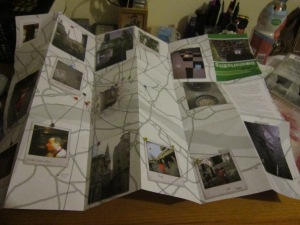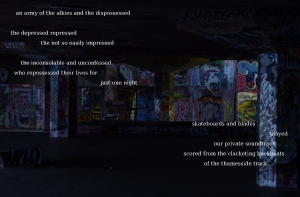The new, fully edited, beautifully produced edition of The Man Who Painted Agnieszka’s Shoes will be launched next March. In the lead up to that, and in the spirit of a book that was written in a Facebook group and was the product of some wonderful conversations with readers, I thought I’d post some essays, extracts, character sketches, backstories related to the book and so on in the run up to the release.
I want to start by circling around two subjects I come back to again and again that are intimately related. Art is something I come back to again and again – I can’t imagine a book or story without it, in fact – and galleries in particular, but that’s for another essay. What I want to talk about here is street art – a category I am deliberately leaving rather porous but in which I include street art, street poetry, parkour, skateboarding, urban exploring – pretty much any form of expression in an urban setting that is driven from the grass roots up and seeks to create an enhanced experience within our cityscapes.
(The skatepark in the Southbank undercroft, a magical physical, ideological, and expressive space at the heart of my poem Hungerford Bridge)
Second, I want to talk about space – specifically the way we occupy space. This is one of the key subjects of the twenty first century. It has always been a delicate, dangerous topic, as the notion of space has progressed from one of territory, to one of personal boundaries, to a political keystone in the perpetuation of patriarchy, to a time now when we leave our footprints simultaneously on the ground and in the corridors of cyberspace.
The question “what space do I occupy and how do I occupy it?” is intimately tied up with the question “Who am I?” If I am a body then I occupy a matrix of coordinates roughly coterminus with the cells of that body. If I am a mind, then I occupy a far more complex matrix coterminus with the reach of my consciousness, or my influence, or my memory, or some other complicated recipe. Probably space is something far more subtle than either of those.
(these friendly ducks are the latest tags to have appeared in Oxford. The city’s older university has responded by asking all staff to be on the lookout so they can shop the perpetrator)
Street art – as defined above – is an expression of something equally complex. It is at once an expression of our physical bodies in their physical environments. It is a way of, for want of a better word, leaking oneself into cracks and corners otherwise ignored or unexplored so as to find out more about oneself and that space. It is a way of altering space as it relates to others, a way of defining oneself, a way of questioning the appropriation of space and the notion of property, of challenging those who in some way share one’s space – whatever that means – to reconsider how they occupy their space – physically and ideologically – and with whom.
The conversation between street art and the occupation of space can take many forms. I am a passionate supporter of the campaign to keep the skatepark in the undercroft of the Southbank where it is rather than forcibly relocating it as part of the National Theatre redevelopment. Not only because this is a place embedded in my work and my consciousness, but because this is the epitome of a ubiquitous battle between culture that grows organically, spontaneously and passionately and a culture that, whilst equally passionate, is organised and funneled through filters of approval. Space is at work on many levels – from questions of how we make use of our city’s physical spaces, and who should decide what us we make of which space, to questions of visibility and how the marginalised and the outsiders – and the establishment – conceive of themselves in relation to their environment.
 (Amniotic City – a work that illuminates an occupation of space that never went away but needs uncovering by clearing away the dust of perception)
(Amniotic City – a work that illuminates an occupation of space that never went away but needs uncovering by clearing away the dust of perception)
Lucy Furlong’s Amniotic City, a psychogeographic poetic guide to London’s hidden feminine, is an illustration of the may ways in which entirely different occupations of space can both coexist and undergo a power filter that means one has to be uncovered by the artist, almost like a work of forensic archaeology. Amniotic City details the manifold manifestations of the divine feminine in London, a whole world of meaning that has been hidden not because it is not there, not because it is not prominent, but because we have been made part of a separate ideological space, one that excludes it. Furlong’s work is a reinjection of the feminine into our perception of the world around us.
It can be so difficult for anyone in any way marginalised to find a way to occupy the same space as those who marginalise them – however that space is defined – that the only option for self-expression can be to create an alternate space that has no overlap with it on any level – in The Man Who Painted Agnieszka’s Shoes, Emma and Shuji are both examples of that.
Nonetheless, there are many liminal spaces where there is a tiny overlap of spaces, be it physical, semantic, ideological or other. Often, these will be characterised by a massive imbalance in occupation – in fact, occupation can often be the perfect word to describe them because the dynamic of overlap plays itself out as one of occupation and resistance, of an accepted, formal, managed space on the one hand and a space cluttered by traces, tags, hints, footholds on the other (one of the fascinations of parts of cyberspace is that communities that would be part of the marginalia of “regular society” become a norm into which that society often stumbles blindly, a dynamic I wanted to play out as Dan attempts to get to grips with the closed worlds of fan bulletin borads).
These imbalanced liminal spaces have always fascinated me – when I wrote the eight cuts gallery manifesto, it was couched in terms of doorways where the invitation has always been offered passive-aggressively by the “official” space for its unwelcome co-occupants to join it – the manifesto reverses that, and that is the role art plays in The Man Who Painted Agnieszka’s Shoes. Whether it’s the street art of Skag or the otherworldly art of Ludwig, art offers symbols and clues from a world with its own fully coherent semantic system that, when viewed from another space seem mysterious, preternatural, or threatening.
Which brings me to the final steps of this syncopated dance. Markers from co-occupants of space often feel threatening – and the reaction is often outrage. Which leads to the last of the three (after separation and art) ways in which we find ourselves dealing with sharing space as the marginalised co-resident. Violence. Violence is at the heart of The Man who Painted Agnieszka’s Shoes. often his takes the form of violence against oneself- of the inflicting of pain on oneself. Intrusion of co-existing spaces can often be interpreted as violence – the language (intrusion, irruption, interference) indeed encourages this. To that extent all attempts to occupy a co-occupied space are on a spectrum of violence – and that is something I want to explore. Not the seemingly obvious question of occupation and resistance, but the notion that art, that being oneself in such spaces is an inherently violent thing, and that the perpetration of the violence arises both in the self-expression and in the parsing of that self-expression and the imposed vocabulary through which that parsing occurs.



If an artistic entrance into a co-occupied space is strong and authentically itself and, as you say, coherent on its own unfamiliar terms, then its mere appearance there will indeed be violent, with a violence that’s inevitable, fertile, political, encroaching, implicitly rude to that that space’s incumbents and … well, frankly just the coolest, really. Any change does violence to the restfulness of the status quo; and if it should also succeed in conveying a proper dose of Francis Bacon’s “violence of reality” as well, meaning the violence that fills the very structure of the world we seem to have been plonked into here, then those cosy house-trained approval-funnelling pigeons will find a sudden scary cat getting put most deservedly among them!
excellently put!!!
Pingback: Make the World a More Beautiful Place | dan holloway
An outstanding share! I have just forwarded this onto a
coworker who had been conducting a little research on this.
And he in fact ordered me dinner due to the
fact that I discovered it for him… lol. So
allow me to reword this…. Thank YOU for the meal!!
But yeah, thanx for spending some time to discuss this subject here
on your website.